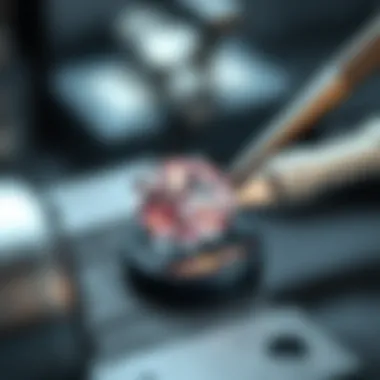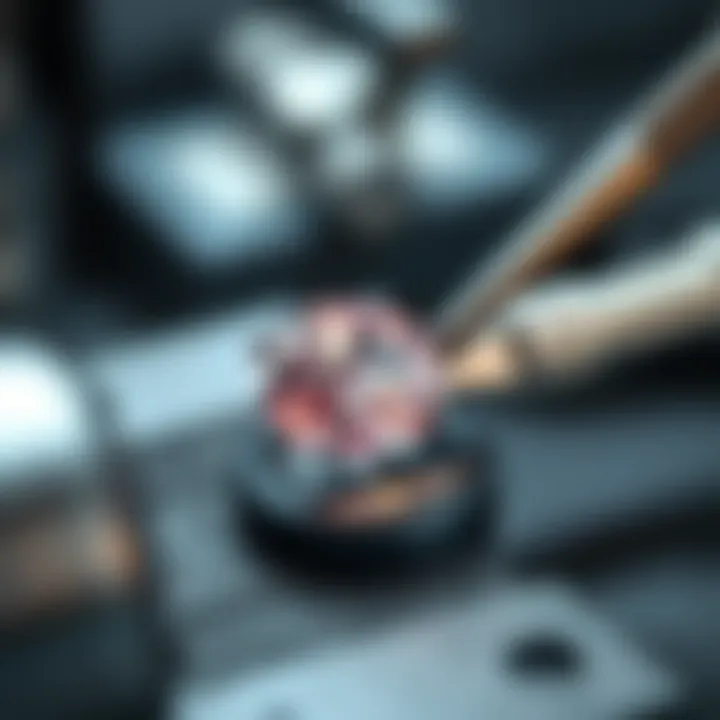Exploring Gemstone Shaping Machines and Their Impact


Intro
In the bustling world of jewelry creation, the role of gemstone shaping machines often goes unnoticed. Many admirers of fine jewelry marvel at the brilliance of gemstones without realizing the intricate processes that render these stones into their dazzling forms. Gemstone shaping machines have transformed the shaping, cutting, and polishing of stones, all while significantly impacting the jewelry industry. This article provides a comprehensive look at the history, types, and technological evolution of these machines, and how they've altered the landscape for jewelers and collectors alike.
The art of gemstone shaping is not just a matter of aesthetics. These machines address practical needs and introduce beneficial advancements that can enhance precision and efficiency. In exploring the various aspects of this craft, we uncover the connection between technology and artistry, emphasizing the importance of understanding these tools for anyone passionate about gemstones.
History and Origins
The journey of gemstone shaping machines starts long before the age of diamonds and exquisite jewelry. The manipulation of stones has been an element of human culture for thousands of years. Ancient civilizations recognized the value of stones, not only for their beauty but also for their utility.
Overview of Collectibles, Rocks, and Fossils
In history, the connection between rocks and cultural practices is rich and varied. From prehistoric times, early humans used natural stones for tools and jewelry. As societies evolved, the crafting of gemstones into beautiful artifacts grew alongside the development of mining and trade.
In terms of collectibles, gemstones have always captured human attention. Different cultures assigned unique meanings and values to various stones. For instance, jade held a sacred significance in Chinese culture, while sapphire symbols of wisdom and royalty in Medieval Europe. This historical significance underpins the craftsmanship that we see today.
Historical Significance and Cultural Impact
The inception of machines for shaping stones can be traced back to the Industrial Revolution when innovations began to revolutionize traditional crafts. The art of gemstone manipulation transitioned from the individualized work of artisans to a more mechanized process. This shift paved the way for mass production, yet artisans still strive for the perfect balance between machine efficiency and hand-crafted finesse.
The cultural impact of this transition is noteworthy. As gemstones became more accessible, the markets expanded, stimulating demand and altering perceptions of luxury. What once was exclusively for the elite became attainable for the masses, leading to a democratization of beauty in the form of jewelry.
Identification and Classification
Understanding gemstone shaping machines requires some insight into the stones themselves. With countless varieties of gems available, proper identification is essential for gem enthusiasts and jewelers alike.
Guide to Identifying Rocks and Fossils
Collecting gemstones and fossils entails more than just having a good eye. It includes knowing the subtle differences in color, texture, and composition. Some key points to consider are:
- Luster: How light interacts with the surface.
- Hardness: Measured by the Mohs scale, the hardness indicates a gemstone's durability.
- Streak: The color of the powder left when a gem is scratched against a porcelain plate.
Using these characteristics, collectors can identify prized stones and distinguish them from imitations or lesser varieties. This knowledge is crucial for making informed purchases and collections that not only depict beauty but also value.
Common Types and Variations
Several types of gemstones are favored in various markets. For example:
- Diamonds: Renowned for their hardness and brilliance, often used in engagement rings.
- Emeralds: Known for their vibrant green, they require careful handling due to their potential inclusions.
- Amethyst: Popular in casual jewelry, this quartz variety is cherished for its soothing shades of purple.
- Topaz: This gem comes in a range of colors and is recognized for its brilliance and clarity.
A machine's capacity to shape these stones further enhances their appeal, ensuring they meet consumer expectations while retaining inherent qualities.
Understanding the complexities involved in gemstone crafting allows us to appreciate the technology behind it, nurturing admiration for both the material and the craftsmanship.
As we continue to unpack the intricacies of gemstone shaping machines, we will delve deeper into the technological advancements that have shaped this craft and examine the environmental implications of their use.
Prolusion to Gemstone Shaping Machines
The world of gemstones is not just about their dazzling appearance; it's also about the meticulous processes involved in shaping these natural wonders into breathtaking pieces of jewelry. Understanding gemstone shaping machines is crucial for anyone involved in this industry, be it a jeweler, collector, or simply an admirer of these earth-formed treasures. These machines represent a blend of artistry and technology, transforming rough stones into polished delights with precision and efficiency.
Definition and Purpose
Gemstone shaping machines, in essence, are specialized tools designed to carve, smooth, and polish gems to achieve the desired shapes and finishes. Their primary purpose is to maximize both the aesthetic qualities and commercial value of gemstones. From diamond to amethyst, the right machine can make all the difference in how a stone is presented.
These machines come in various forms, each equipped for specific tasks—be it cutting, grinding, or polishing gemstones. For example, CNC machines utilize computer programs to ensure that every cut is accurate, while lathes enable jewelers to create intricate shapes by rotating the stone against the cutting tool. Such precision is paramount; a millimeter off could mean a loss of brilliance or even value.
Importance in the Jewelry Industry
The jewelry industry relies heavily on these machines for several reasons, foremost among them being efficiency and scalability. In a world where trends can change overnight, the ability to produce consistently high-quality shaped stones is critical. Manual shaping methods, while artistic, may not meet the increasing demand for precise and uniform pieces. Thus, gemstone shaping machines play a pivotal role, enabling jewelers to meet customer needs without compromising quality.
Moreover, these machines contribute significantly to innovation within the crafting process. They allow for complicated designs that might be too intricate or labor-intensive to achieve by hand. The introduction of automation has further pushed the boundaries of creativity, granting artists the freedom to experiment with shapes that capture the elusive beauty of each stone.
In summary, understanding gemstone shaping machines equips us with the knowledge of how these tools not only enhance the beauty of gemstones but also drive the jewelry industry forward. They are, without a doubt, the unsung heroes of craftsmanship, weaving technology into the fabric of art.
Historical Context of Gemstone Shaping
The history of gemstone shaping is a journey through time, tracing back to the earliest civilizations where stones were not merely ornamental but held spiritual or practical significance. Each period has contributed unique techniques and understanding that frame our present-day practices. This context is crucial in grasping the significance of modern gemstone shaping machines, which are the culmination of centuries of craftsmanship and innovation.
Evolution of Techniques
From the rudimentary flint tools used by ancient artisans to the sophisticated machinery of today, the evolution of techniques in gemstone shaping reflects a blend of artistry and engineering. In centuries past, artisans utilized hand-held tools like chisels and drills made from harder materials to shape crude stones. For instance, the Egyptians prized lapis lazuli, which they meticulously carved using simple abrasive techniques. These efforts were time-consuming and dependent on the skill of the craftsman, often resulting in uneven surfaces and imperfect cuts.


As time progressed, the Renaissance brought about an increased emphasis on precision. The invention of the wheel saw the advent of turning stones, allowing for more refined shapes. By the 18th century, the introduction of steam-powered equipment marked a significant milestone, enabling artisans to increase production without compromising on quality. The mechanical lapidary saw, developed during this time, allowed for more complex and intricate designs, accommodating the growing demand for gemstone jewelry.
Today, we stand on the shoulders of these giants, utilizing Computer Numerical Control (CNC) machines that can produce flawless gems with unprecedented accuracy. The integration of digital tools in crafting gemstones allows artists not only to replicate perfect shapes but also to experiment with innovative designs that would have seemed impossible in earlier epochs.
Traditional Methods vs. Modern Technology
Tradition and modern technology do not always clash; often, they complement one another remarkably. Traditional gemstone shaping methods emphasize the artisan's touch, imbuing each piece with character that machine-made versions might lack. Techniques such as hand-polishing or facet cutting remain revered for the individual flair they lend to gemstones. For many collectors, the value of a gemstone lies not just in its appearance but also in the story behind its creation, forged through hours of skilled labor.
On the flip side, modern technology, particularly CNC machines, has revolutionized the landscape of gemstone cutting. They provide consistency that a human hand cannot replicate—not merely in the shape of the stone but also in the intricate patterns and finishing touches. Moreover, the setup can work with various gemstones, ensuring that the right settings are precise and seamless. This technological prowess often allows for mass production of stones while maintaining high-quality standards.
Types of Gemstone Shaping Machines
Gemstone shaping machines are essential in the jewelry-making world. They allow craftsmen to mold precious stones into stunning pieces of art. Each type of machine has its own specific application and benefits. In this section, we'll explore three main categories: CNC machines, lathes, and polishing machines. Understanding these types will help collectors appreciate the craftsmanship behind the jewelry they admire.
CNC Machines
CNC, or Computer Numerical Control machines, are a game-changer in gemstone shaping. These machines operate using precise algorithms to cut and shape gemstones with remarkable accuracy. They can handle various shapes and sizes, making them incredibly versatile.
One major advantage of CNC machines is their efficiency. They can work continuously, producing multiple stones in a shorter time compared to manual techniques. As a result, they not only save time but also reduce labor costs, making it feasible for both small and large workshops to operate.
Moreover, CNC machines have a low error rate. This precision ensures that each piece produced is consistent in quality, significantly enhancing the overall craftsmanship. For collectors, knowing that a particular piece has been shaped with such precision adds to its value.
"CNC machines drastically shift the paradigm of how gemstones are processed, allowing for stunning complexity that would be nearly impossible with traditional methods."
Lathes
Lathes are perhaps the oldest tool in the gemstone shaping toolkit. They rotate the gemstone while shaping it with controlled cutting tools. This method is particularly effective for creating symmetrical shapes, like beads and cabochons.
While not as advanced as CNC machines, lathes require a fair amount of skill and knowledge. The operator must understand the intricacies of the machine's controls and how to manipulate the gemstone effectively. This aspect brings a unique human touch to the process, as experienced craftsmen can infuse their personal style into each piece.
Another important factor to consider is the cost. Lathes are generally less expensive compared to CNC machines, making them an appealing option for jewelers just starting out. They also have fewer electronic components, which means maintenance can be simpler and less costly.
Polishing Machines
Polishing machines play a crucial role in the finishing process of gemstone shaping. After a stone has been cut and shaped, polishing enhances its final appearance by removing any rough edges and giving it a brilliant shine.
These machines often use various polishing compounds and pads to achieve different levels of gloss. For instance, harder stones might require more aggressive polishing materials to achieve that sought-after luster.
The efficiency of polishing machines also cannot be overstated. While manual polishing is labor-intensive and time-consuming, a polishing machine can streamline this to produce a smooth finish in a fraction of the time. This ability to enhance gemstones effectively can make a critical difference, especially for high-end jewelry pieces.
In summary, each type of gemstone shaping machine has its own significance. CNC machines offer modern efficiency, lathes provide traditional craftsmanship, and polishing machines enhance the final product's appeal. Collectively, they contribute to the intricate process of gemstone shaping, allowing for creativity and precision in every piece crafted.
Functionality and Features
In the realm of gemstone shaping, a machine's functionalities and features play a pivotal role in determining not just the efficiency but also the quality of the finished product. As technology progresses, the intricacies of these machines become critical in keeping with the demands of both jewelers and collectors alike. By exploring control options and cutting precision, we can appreciate how essential these elements are to the gemstone shaping process.
Control and Programming Options
When discussing control options, one must consider how machines are programmed to perform various tasks. The user interface of many modern machines has become quite intuitive, merging complex functionalities with user-friendly designs. For instance, some CNC machines incorporate a touchscreen interface that allows jewelers to select specific designs from a database. This feature significantly reduces setup time and enhances productivity.
Moreover, the programming capabilities often include features like:
- Customizable Templates: Users can save frequently used designs, making repeat work seamless.
- Simulation Modes: Some machines can simulate the shaping process, allowing operators to troubleshoot errors before actual cutting begins, thus saving time and material.
- Multi-Axis Control: Advanced machines can manage movements across various dimensions, allowing for intricate designs that would be nearly impossible to achieve manually.
Programming these machines generally requires a basic understanding of CAD (Computer-Aided Design) software. Brushing up on software skills can be beneficial for collectors who wish to engage more deeply with the shaping process or even design their own unique pieces.
Cutting Precision and Versatility
Cutting precision stands out as a hallmark feature that distinguishes high-quality shaping machines from their less efficient counterparts. The sheer level of detail achievable with modern machines allows for intricate facets and delicate carvings that greatly elevate the overall aesthetic of gemstones. In instances where fractions of millimeters make a significant difference, this precision proves indispensable.
Consider the following:
- Laser Cutting: Some high-end shaping machines employ laser technology, which offers unmatched precision when embarking on detailed patterns or delicate cuts.
- Adaptive Cutting Techniques: Machines that can adjust their cutting speed based on the material being processed can significantly enhance versatility. Thus, switching between softer stones like turquoise to harder ones like sapphires becomes less cumbersome.
- Real-Time Adjustments: The ability to make adjustments on-the-fly during the shaping process allows operators to correct errors, ensure better finishes, and maintain a high standard of quality control.
Notably, the investments made in cutting precision can translate to greater profits in the long run. Richly detailed gemstones often fetch higher prices at market. Whether for a collector looking to enhance their collection or a jeweler aiming to create standout pieces, investing in machines with superior cutting capabilities is indispensable.
A well-functioning machine can cut down production time significantly without compromising on quality, paving the way for more intricate and profitable designs.
Culmination
Understanding functionality and features supports a more comprehensive appreciation of gemstone shaping machines. Advanced control and programming options paired with cutting precision provide not just the tools but the creativity needed for stunning outcomes. Jewelers and collectors who harness these capabilities can elevate their craftsmanship, meeting even the highest standards of the industry. For further reading on gemstone machinery, resources such as Wikipedia and Britannica can provide deeper insights into these technologies and their applications.
Materials Handled by Shaping Machines


Understanding the types of materials that are manipulated by gemstone shaping machines provides a critical backdrop to their functionality and application in the jewelry-making process. Each material, whether natural or synthetic, poses unique challenges and benefits, influencing both the techniques employed and the final outcomes. Hence, gaining this insight is paramount for jewelers and collectors alike, as it enhances their appreciation of the machines' intricate work and effects on gemstones.
Varieties of Gemstones
Gemstones can be broadly classified according to their chemical composition and crystal structure. Each variety brings its own set of characteristics, requiring specialized techniques for shaping and polishing. For instance:
- Diamond: Known for its exceptional hardness, diamonds require high-precision machinery to achieve the desired cuts and polish. Their value often dictates the use of the most advanced shaping machines.
- Ruby and Sapphire: These corundum varieties are not just prized for their colors but also for their durability. Their shaping process often uses techniques that balance cutting speed with precision to ensure the gem retains its vivid hues and clarity.
- Emerald: Due to their tendency to have inclusions, emeralds require gentler handling. Machines designed for these stones are often set to lower speeds to avoid damaging the gem's structure while achieving a fine finish.
- Opal: This stone presents unique challenges due to its play-of-color and varying hardness. Specialized shaping machines are necessary to preserve the beauty of each unique opal without losing its iridescence.
It is important to know that the world of gemstones is vast, with countless variations on the market. Each type not only has its own intrinsic beauty but also its own technical requirements when it comes to shaping and polishing.
Synthetic vs. Natural Materials
The dividing line between natural and synthetic materials has grown increasingly blurred in the gemstone industry, which poses an interesting dynamic for shaping machines.
Natural Materials
Natural gemstones are formed over millions of years beneath the earth’s crust, resulting in unique imperfections and colors. They hold value not only in their beauty but also in their rarity. When handling natural materials, the shaping machines must be calibrated to accommodate the inherent irregularities that can be inside these stones. The experienced jeweler understands each gemstone's nature and intricacies, guiding the shaping process.
Synthetic Materials
In contrast, synthetic gemstones are created in laboratory settings, often designed to mimic their natural counterparts. These alternatives can provide a more uniform structure that allows for faster and more efficient shaping with high precision machines. Synthetic stones have the added benefit of lower costs and eco-friendliness that appeal to modern consumers. Many consider them a viable option, not just for ethical reasons, but for their consistent quality. However, the perception of value differs; thus, the techniques and equipment for processing these stones often diverge as well.
As the industry evolves, understanding the implications of using both natural and synthetic materials continues to shape attitudes and approaches in gemstone shaping.
Ultimately, knowledge of the materials handled by shaping machines opens doors to more refined techniques and approaches, ensuring both jewelers and collectors can utilize the machines to their fullest potential while embracing the nuances between each gemstone type.
Benefits of Using Machines for Shaping
Gemstone shaping machines are not just tools; they are the backbone of modern gem cutting and polishing operations. In this section, we’ll break down the undeniable advantages these machines bring to the table, from boosting efficiency to ensuring quality that meets the highest standards.
Increased Efficiency
When it comes to the realm of jewelry production, time is money. The increased efficiency offered by gemstone shaping machines helps reduce the time it takes to transform raw stones into dazzling pieces ready for sale. For instance, a CNC machine can cut and shape stones rapidly, leaving human artisans to focus on clusters that require delicate touch.
- Speed: Unlike traditional hand-cutting techniques, machines can execute repetitive tasks faster without sacrificing precision. This enables jewelers to ramp up their production rate significantly.
- Reduced labor costs: Fewer hours spent on basic shaping mean that less manpower is needed, allowing artisans to delegate their efforts to more intricate processes or even pursuing new designs.
- Fewer errors: Machines come with built-in settings that minimize human error, reducing waste, which in turn lowers operational costs. Think about it: with machines doing the heavy lifting, the possibility of a miscut gem is drastically severed.
"In the fast-paced jewelry industry, efficiency isn’t just a bonus; it’s a necessity. Machines have transformed what used to take days into mere hours of work."
This blend of speed and precision makes machines an indispensable asset in gem shaping operations, showing how technology can complement craftsmanship.
Enhanced Consistency and Quality
Turning your gaze next to consistency and quality, machines excel in delivering results that are uniform across batches. When your business thrives on quality assurance, machines raise the bar to ensure every gem emerges pristine.
- Uniform cutting: Machines operate on precise algorithms that guarantee uniformity. This is especially crucial when creating a large number of similar items. Compare that to manual labor; one artisan might cut a stone just a tad differently than another, introducing variability that is undesirable.
- High-quality finishes: Polishing machines specifically make sure that the gemstones shine with a uniform brilliance that captivates collectors and buyers alike. The ability to replicate a perfect finish multiple times is hard to achieve through manual methods.
- Control over specifications: Advanced shaping machines allow designers to input exact specifications for the gem cuts. This means fewer surprises down the line, as what comes out of the machine is what was input into it, according to design standards.
With machine-assisted shaping, the quality of gems can be closely monitored and aligned with established industry standards, ensuring they meet customer expectations and market demands.
Challenges and Limitations
Understanding the challenges and limitations associated with gemstone shaping machines is crucial for those involved in the jewelry and gemstone industry. These machines, though incredibly beneficial, come with their own set of hurdles that users must navigate to ensure optimal operation and output. A detailed exploration of these aspects not only sheds light on operational efficiencies but also on potential pitfalls that could impact production quality and costs.
Cost Considerations
The financial aspect of acquiring and maintaining gemstone shaping devices cannot be overlooked. The initial investment for high-quality shaping machines can be steep, with prices varying significantly based on the technology, brand, and capabilities of the equipment. For instance, a CNC machine used for intricate gemstone cuts can run upwards of tens of thousands of dollars. This heavy upfront cost could be a dealbreaker for smaller jewelers or hobbyists trying to enter the market.
Apart from initial costs, users must also consider ongoing expenses such as:
- Operating Costs: These include electricity, tools, and other consumables necessary for machine operation.
- Training Expenses: Operators may require specialized training to maximize the machine's potential, which can add to the overall financial burden.
- Software Upgrades: As technology evolves, software updates are necessary for enhanced performance. These can incur additional costs over time.
Thus, while machines can significantly raise efficiency and precision, judicious financial planning is vital to balance these investments against potential returns. A proper assessment of total cost of ownership can aid in making an educated call on whether investing in such technology makes financial sense for individual operations.
Maintenance and Repairs
Regular maintenance of gemstone shaping machines is non-negotiable, yet it can pose a significant challenge. Just like any complex machinery, these devices demand consistent upkeep to ensure smooth operations. Neglecting maintenance not only impacts performance but also risks the quality of the finished gemstones.
Common issues that arise include:
- Wear and Tear: Parts such as bearings and cutting tools can deteriorate, necessitating replacements that can be costly and may lead to downtime.
- Calibration: Machines need to be periodically calibrated to maintain precision. Misalignment can lead to incorrectly shaped stones, which might not meet customer expectations, ultimately impacting business reputation.
- Technical Failures: Like any piece of advanced technology, these machines may experience software glitches or breakdowns, often requiring specialized technicians for repairs.
To mitigate these challenges, establishing a regular maintenance schedule is essential. Furthermore, it's prudent to create a contingency fund to cover unexpected repairs or downtime. Investing in a warranty or service plan with the manufacturer can also alleviate some of the financial pressures and ensure prompt repairs when needed.
In summary, continual upkeep and a sound understanding of financial implications are key to successfully integrating gemstone shaping machines into any jewelry operation.


Successful gemstone shaping is as much about skill as it is about the machinery involved. While these machines can deliver incredible advantages in efficiency and precision, it is upfront and ongoing costs, as well as maintenance challenges, that the industry players must face head-on to thrive.
Environmental Impacts
The conversation around gemstone shaping machines extends beyond mere functionality and efficiency; it touches on critical environmental considerations that become increasingly important in today's eco-conscious world. Understanding the environmental impacts of these machines is key for jewelers and collectors alike. As we're striving for advancements in technology, it is equally imperative to acknowledge their effects on our planet. In this section, we will dissect two pivotal aspects: waste management and sustainability practices.
Waste Management
When operating gemstone shaping machines, the process generates not only beautiful stones but also a byproduct of waste materials. Gemstones themselves might be resilient, but their processing can result in a significant amount of leftover dust, shards, and other debris. Proper waste management is crucial for mitigating negative environmental consequences.
Imagine a workshop that fails to contain this off-cut material; it ends up contaminating local landscapes and ecosystems. Efficient waste management systems can fill this gap. That might look like collecting unwanted pieces for recycling or ensuring that any chemicals used in the process do not seep into the earth.
Here are a few approaches that can be adopted for effective waste management in gemstone shaping:
- Recycling Dust and Shards: Collecting and repurposing these materials can minimize overall waste. They can be transformed into smaller gems or even used in jewelry designs.
- Responsible Disposal: When recycling isn't an option, the proper disposal of hazardous materials ensures that the impact on the environment is kept in check.
- Maintaining Equipment: Investing in high-quality machines that limit waste through precision contributes to better waste management.
"Effective waste management not only benefits the environment but also reflects a commitment to responsible sourcing in the gemstone industry."
Sustainability Practices
In the realm of gemstone shaping, sustainability does not only refer to managing waste but also encompassing practices that minimize resource consumption and environmental strain. As the demand for gemstones increases, so does the scrutiny of how they are shaped and sourced.
Sustainability practices can be integrated into every stage of the shaping process. Here are some key areas to consider:
- Energy Efficiency: Opting for machines that use less energy not only holes down operation costs but also lessens the carbon footprint of shaping processes. This can include the use of solar-powered equipment.
- Water Use Reduction: Many shaping processes require water for cooling and polishing. Using closed-loop systems reduces water waste significantly.
- Ethical Sourcing of Materials: Transparency in sourcing practices can foster sustainability. Machines should be used to shape ethically sourced gemstones to promote responsible consumption.
- Awareness and Education: Training operators on eco-friendly practices and the importance of sustainability can create a culture of conscientious craftsmanship.
In a world grappling with environmental challenges, gemstone shaping is no exception to the rule of responsibility. Embracing waste management strategies and sustainability practices not only preserves the planet but also enhances the reputation of the jewelry and collector community. By prioritizing these aspects, industry players gain not just yesterday's treasures but also protect tomorrow's legacies.
Future Trends in Gemstone Shaping Technology
As technology marches forward, the realm of gemstone shaping continues to evolve, incorporating innovations that enhance precision and creativity in the craftsmanship of gemstones. This section examines the cutting-edge developments in gemstone shaping technology, paving the way for a future where automation and artificial intelligence redefine traditional practices.
Advancements in Automation
Automation stands as a cornerstone in the future of gemstone shaping. It allows for the significant reduction of manual labor and the margins of error that humans inevitably bring into the equation.
Here are some notable advancements to watch for:
- Robotic Arm Integration: Gemstone shaping machines are increasingly utilizing robotic arms capable of executing intricate designs with remarkable speed. These robotic systems can repeat patterns flawlessly, ensuring every cut and polish meets high standards.
- Smart Sensors: Machines equipped with smart sensors can automatically adjust their operations, responding in real-time to variations in material hardness or unexpected flaws in gemstones. This not only improves efficiency but also enhances the quality of the final product.
- Batch Processing: Advanced automation allows machines to process multiple stones simultaneously. With the right programming, a single machine can transition between different types of stones, optimizing production flow.
The net effect of these automation trends is not only increased productivity but also expanded creative possibilities for gem artisans. As machines handle more of the repetitive tasks, jewelers can focus on design and artistry, leading to richer, more aesthetically pleasing final products.
Integration of Artificial Intelligence
Artificial intelligence is quickly becoming a game changer in various industries, and gemstone shaping is no exception. The integration of AI technologies into shaping machines offers compelling advantages that could reshape the craft as we know it.
Here’s how AI is making waves in this field:
- Pattern Recognition: AI can analyze existing designs and predict trends in gemstone fashion. By studying consumer preferences and market trends, AI can inform gem processors about the types of cuts and styles that may appeal to buyers.
- Predictive Maintenance: Using machine learning algorithms, AI systems can monitor equipment health and predict when maintenance is needed. This reduces downtime and keeps the machines operating at peak performance.
- Custom Design Capabilities: With AI, customers can visualize custom designs in real-time. By inputting specific preferences, AI-driven machines can quickly generate complex shape variations that suit individual tastes.
"The blending of artificial intelligence with gemstone shaping may lead not only to improved efficiencies but more innovative designs, allowing artisans to push the boundaries of their craft."
Both advancements in automation and the integration of artificial intelligence are instrumental for the future of gemstone shaping technology. By embracing these trends, jewelers and collectors will find themselves navigating a landscape where creativity meets technological prowess, all contributing to more sustainable and compelling gem craftsmanship.
For further information on the implications of automation and AI, see links at Wikipedia and Britannica.
As we look ahead, it is evident that to keep pace with these innovations, this industry must embrace change vigorously, evolving along with the technology that shapes not just gemstones, but also the future of artistry in the jewelry sector.
Finale
In the realm of gemstone shaping, the conclusion serves as a crucial point where the threads of various discussions weave together. It encapsulates the significance of understanding the technology, techniques, and tools involved in this intricate art form. This article provides a substantive overview of gemstone shaping machines, shining a light on how they revolutionize the jewelry industry.
Summary of Key Insights
Understanding gemstone shaping machines goes beyond mere operational knowledge; it unveils the technology that drives the industry forward. Key insights from various sections reveal that these machines not only streamline the shaping process but also elevate the quality when it comes to the final product. Their precision impacts everything, from cutting raw gemstones to creating exquisite finished pieces. Some notable points include:
- Technological Evolution: The progression from traditional techniques to modern CNC machines signifies a leap in both efficiency and consistency.
- Materials Versatility: The ability of machines to handle a spectrum of gemstones, whether synthetic or natural, showcases their adaptability.
- Environmental Responsibility: As discussed, advancements in technology are also focusing on sustainable practices, ensuring that the industry can thrive without compromising ecological integrity.
The Importance of Adaptation in Craftsmanship
The jewelry industry is often perceived as a harmonious blend of artistry and technology, where the finest pieces are crafted through skillful hands but also sophisticated machines.
Adaptation plays a pivotal role here. In a world driven by rapid technological advancements, jewelers must not only embrace these changes but also find a balance between artistry and machine efficiency. To remain relevant, jewelry artisans are encouraged to learn how to work alongside these machines. By integrating both traditional craftsmanship and cutting-edge technology, they can optimize their production processes while still keeping their unique touch.
As gemstone shaping machines evolve, artisans who adapt will be the ones who not only survive but thrive in this dynamic landscape. Understanding and embracing change allows for a richer narrative in craftsmanship, ultimately delighting collectors who seek not just beauty but also the story behind each piece.
"To evolve is to enrich the narrative of craftsmanship itself."
In light of these discussions, it is clear that understanding how gemstone shaping machines operate and their broader implications can lead to a more nuanced appreciation for the craft. The blend of science, artistry, and sustainability necessitates an informed audience, encouraging collectors and jewelers alike to invest in knowledge as much as in materials. Uncovering these layers enhances not only the value of the gemstones but also the respect for those who dedicate their lives to this fine trade.



